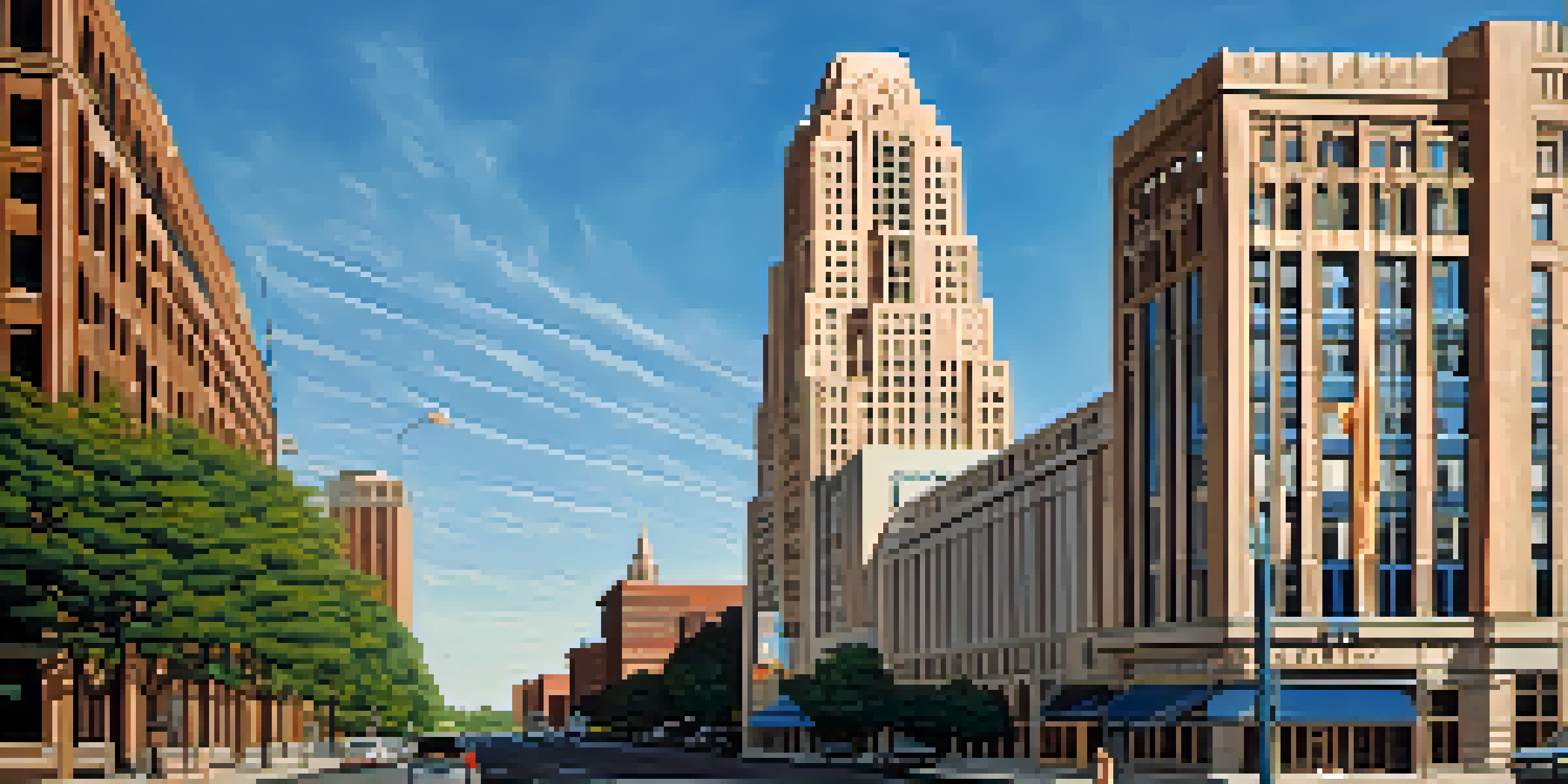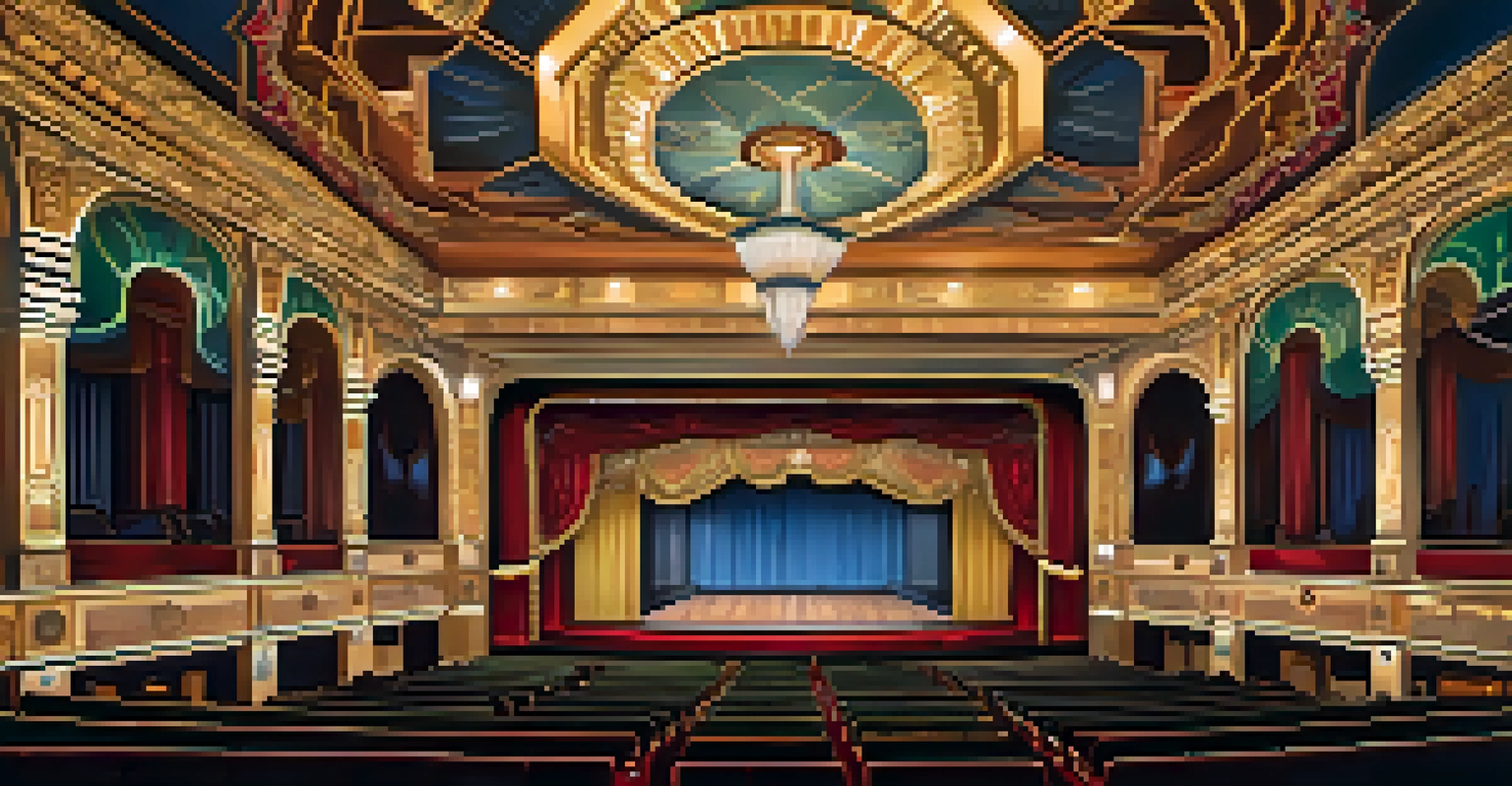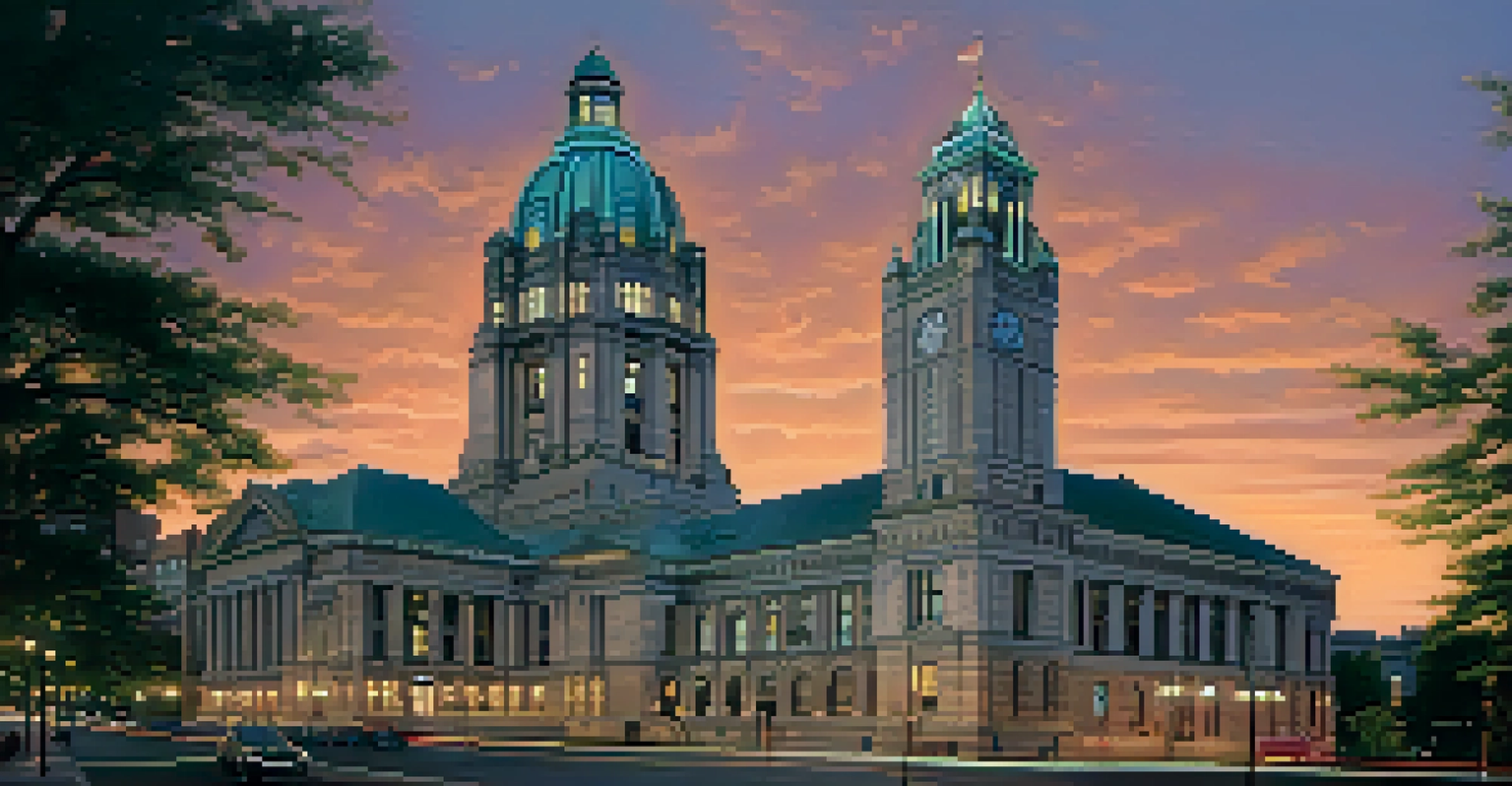Art Deco Influences in Minneapolis Architecture: A Visual Tour

What is Art Deco? A Brief Overview of the Style
Art Deco is a design style that emerged in the 1920s and 1930s, characterized by its bold geometric shapes, vibrant colors, and lavish ornamentation. This style often evokes a sense of luxury and glamour, making it a favorite for both architecture and decorative arts. It stands in stark contrast to the more austere styles of the previous era, focusing instead on the celebration of modernity and consumer culture.
Art Deco is like a dream of the future, a style that embodies the spirit of the 1920s and 1930s.
In Minneapolis, Art Deco influences can be seen in various buildings that reflect the city's growth and ambition during the early 20th century. The clean lines and intricate details of this architectural style capture the spirit of innovation that defined the Roaring Twenties. As we explore the city’s landscape, we’ll uncover how Art Deco played a significant role in shaping its skyline.
From theaters to skyscrapers, Art Deco architecture in Minneapolis tells a story of a vibrant city embracing modernity. By understanding the essence of this style, we can appreciate the historical context and artistic vision that continue to inspire architects today.
Key Characteristics of Art Deco Architecture
Art Deco architecture is easily recognizable by its unique characteristics, including bold geometric patterns, stylized motifs, and a sense of elegance. Often, buildings feature symmetrical designs and decorative elements that draw the eye upward, creating an impression of grandeur. The use of materials like chrome, glass, and concrete further enhances the distinctive look of this style.

In Minneapolis, these features can be spotted in many iconic structures, where architectural elements seem to dance in harmony with the city's skyline. For instance, buildings often showcase zigzag patterns and chevrons, which were popular during the Art Deco movement. These details illustrate not only artistic creativity but also the technological advancements of the era.
Art Deco: A Symbol of Modernity
Emerging in the 1920s and 1930s, Art Deco embodies luxury and innovation, significantly influencing Minneapolis' architectural landscape.
By examining these characteristics, we gain insight into the mindset of the time when these buildings were constructed. The desire for progress and sophistication is palpable in the design, making Minneapolis a treasure trove of Art Deco gems.
The Foshay Tower: A Beacon of Art Deco Design
One of the most iconic examples of Art Deco architecture in Minneapolis is the Foshay Tower. Completed in 1929, this skyscraper stands as a testament to the city's ambition and flair for modern design. The tower's design features a stunning combination of limestone and terra cotta, adorned with intricate reliefs and decorative details that embody the Art Deco aesthetic.
Architecture should speak of its time and place, but yearn for timelessness.
At 447 feet tall, the Foshay Tower was the tallest building in Minneapolis for many years and remains a prominent part of the skyline. Visitors can marvel at the grandeur of its lobby, which features stunning murals and a grand staircase that exude the elegance of the Art Deco period. This building is not just an architectural marvel; it's a historical landmark that connects us to the city’s past.
Today, the Foshay Tower serves as a reminder of the boldness of the Art Deco movement and its lasting impact on Minneapolis' architectural landscape. Its legacy continues to inspire new generations of architects and design enthusiasts alike.
The Orpheum Theatre: A Cultural Art Deco Gem
The Orpheum Theatre, built in 1921, is another stunning example of Art Deco architecture in Minneapolis. This former movie palace is renowned for its opulent design, which includes intricate plasterwork and lavish chandeliers that transport visitors back to the golden age of Hollywood. The theater's facade is adorned with bold geometric shapes and vibrant colors that capture the essence of the Art Deco style.
Inside, the Orpheum is a feast for the senses, with a grand auditorium that boasts a richly decorated ceiling and plush seating. It has undergone several renovations, but the Art Deco elements have been lovingly preserved, allowing audiences to experience the glamour of the era. The theater not only showcases architectural beauty but also serves as a cultural hub for the performing arts.
Iconic Buildings Showcase Art Deco
Structures like the Foshay Tower and Orpheum Theatre exemplify the vibrant design and historical importance of the Art Deco style in the city.
As you attend a show at the Orpheum, you can appreciate the blend of history and artistry that defines this landmark. It stands as a testament to the city's commitment to preserving its architectural heritage while providing a space for creative expression.
Minneapolis City Hall: Marrying Function and Style
Minneapolis City Hall, completed in 1906, is an architectural masterpiece that features elements of the Art Deco style, despite its roots in the Romanesque revival. The building's clock tower, towering over the city, is an iconic symbol of Minneapolis, and its intricate details showcase the craftsmanship of the era. While it may not be a pure example of Art Deco, the building incorporates aspects of the style that reflect the city's evolution over time.
The interior of the City Hall is equally impressive, with grand staircases and decorative ceilings that embody the opulence of the early 20th century. Visitors can admire the beautiful murals and intricate mosaics that tell the story of Minneapolis' history. It is a space where the past meets the present, demonstrating the city’s commitment to blending functionality with artistic expression.
By exploring the City Hall, we see how Art Deco influences can enhance civic architecture, creating a sense of pride and identity for the community. It invites us to reflect on the importance of preserving our architectural heritage while embracing contemporary design.
The Impact of Art Deco on Minneapolis' Identity
The influence of Art Deco on Minneapolis architecture has significantly shaped the city’s identity. This movement captured a sense of optimism and modernity during a transformative period in American history. The architectural style reflects the aspirations of a growing city, positioning Minneapolis as a hub of culture, innovation, and style.
As Art Deco buildings emerged throughout the city, they contributed to a unique urban landscape that continues to attract visitors and residents alike. Each structure tells a story, showcasing the craftsmanship and creativity of the time. The vibrant designs and attention to detail highlight the city’s commitment to beauty and progress.
Preservation Efforts for Heritage
Ongoing preservation initiatives ensure that Minneapolis' Art Deco architecture is maintained, allowing future generations to appreciate this artistic legacy.
Today, the legacy of Art Deco is celebrated through preservation efforts and architectural tours, allowing us to appreciate the historical significance of these buildings. By embracing this heritage, Minneapolis honors its past while inspiring future generations to create and innovate.
Preservation Efforts: Keeping Art Deco Alive
As the years go by, the preservation of Art Deco architecture in Minneapolis has become increasingly important. Many of these buildings are not only significant for their design but also for their historical context. Efforts to preserve and restore these structures ensure that future generations can appreciate the artistry and craftsmanship that define this architectural movement.
Organizations and local government initiatives work together to identify and protect Art Deco sites, encouraging community engagement and education. Restoration projects often involve careful attention to detail, ensuring that the original design elements are maintained while updating facilities for modern use. This balance highlights a commitment to honoring the past while meeting contemporary needs.

By participating in preservation efforts, residents and visitors alike can contribute to the ongoing appreciation of Art Deco. Each restored building serves as a monument to the city's rich architectural history, reminding us of the creativity and innovation that continue to shape Minneapolis.
Exploring Art Deco: A Visual Journey Through Minneapolis
To truly appreciate the beauty of Art Deco in Minneapolis, taking a visual tour of the city is essential. Numerous buildings showcase this distinctive style, each offering a unique perspective on the era’s architectural trends. From the Foshay Tower to the Orpheum Theatre, a stroll through the city reveals a treasure trove of design marvels waiting to be discovered.
Photography enthusiasts will find endless inspiration as they capture the intricate details and bold lines that define Art Deco architecture. Exploring these landmarks not only provides an opportunity to admire their beauty but also to learn about the history and significance behind each structure. Guided tours are also available, often led by knowledgeable locals who share fascinating stories and insights.
As you embark on this visual journey, you'll gain a deeper appreciation for the artistry that has shaped Minneapolis. The city's Art Deco buildings are not just structures; they are reflections of its heritage, inviting us to celebrate the past while looking forward to the future.